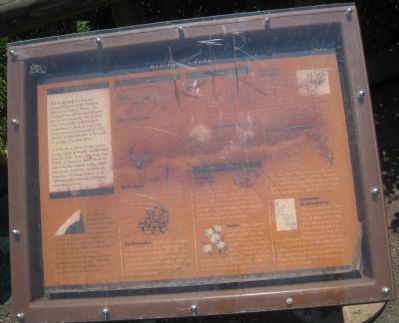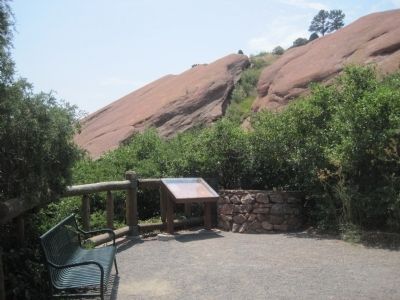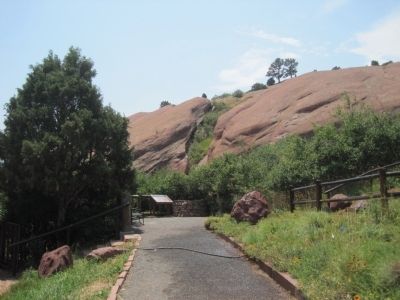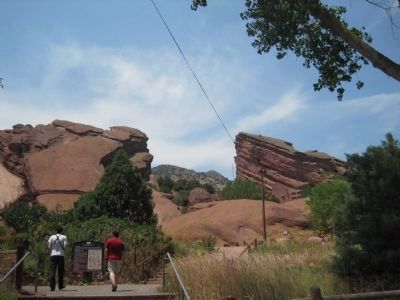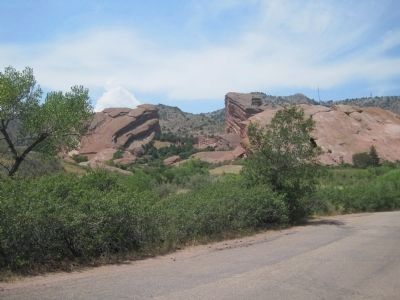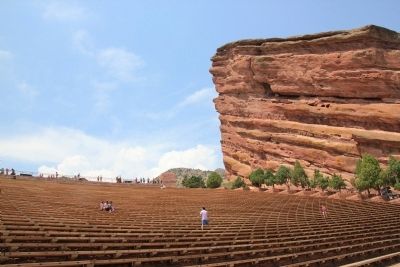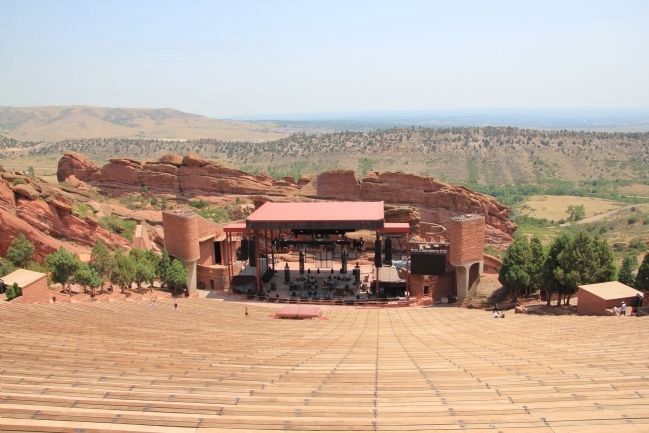Red Rocks Park in Jefferson County, Colorado — The American Mountains (Southwest)
Red Rocks Park
Red Rocks Park is a national Historic District on the National Register of Historic Places. The Trading Post and the Amphitheater are Denver Landmarks. The Trading Post, an example of the Pueblo-style architecture, is made of brick and stucco and was constructed in 1931. Red Rocks Amphitheater is the work of architect Burnham Hoyt.
In 1936, the Civilian Conservation Corps, began carving the Amphitheater from the rock. It was dedicated, after WWII, in August of 1946. Made of little more than wooden seating, simple indigenous materials, and natural acoustics, the Amphitheater is an internationally-renowned, 9,000-seat, performance venue.
The tilted and eroded sandstone and siltstone that you see covers layers of ancient beds of rock that were deposited in the area as layers of sand and mud in streams, lakes and seas. The mountain building that created the Rocky Mountains caused the layers of rock to slowly surge upward, lifting and tilting the red sandstone and siltstone slabs that we know today as Red Rocks.
Animals
Mountain Lion
It has a small round head, neat rounded ears and a heavy tail. Its fur is yellowish brown and dark brown on the ears, nose and tail. All adult males will weigh up to 200 pounds.
Rattlesnake
Rattlers are carnivores, swallowing their prey whole. These venomous snakes usually flee when they sense a threat, but will also use a deterrent display such as the rattling of its tail. The tail rattle is made of bony loosely connected segments.
Birds
American Kestrel
A hovering falcon that feeds on on large insets, small birds, and rodents. To identify this bird look for the way it will hover over prey before it attacks. Both sexes have a blue-grey stripe on the head and dark sideburns.
Mountain Bluebird
[text is unreadable]
Vegetation
(Oenothera caespirosa) This herbaceous perennial grows in cooler climates on dry sunny slopes. Its large white 4-petaled flowers open in the evening and wilt the next day. Since one flower opens at a time, the plant may bloom for days or even weeks throughout the summer. Yucca
(Yucca glauca) Happiest in arid regions and in sandy soil, this low evergreen plant is familiar to desert explorers. Its leaf fibers were used by Native Americans to make cord, sandals, and mats.. The flowers are creamy to greenish white bells, 2-3 inches wide, with large apple-green pistils.
Creeping Mahonia
(Mahonia repens) You will find this low shrubby plant on the dry open hillsides and rocky slopes of the Park. It has woody under ground stems, but is most recognizable by its leathery, hollylike, evergreen leaflets and dark blue berries. The leaves turn bright red in the summer. In the fall, yellow clustering [unreadable] fragrant.
Mountain Mahagony
(Cercocarpus) You will find this member of the rose family on sunny dry rocky slopes. It can grow 4 to 6 feet tall, but sometimes from 12 to 20 feet tall. The Navaho named the plant to signify one whose wood is as heavy as stone. Because of its hardiness they used the wood as staffs to hold wool when spinning it; and as an ingredient in preparing a reddish dye for wool.
Common Chokecherry
(Prunus Virginiana) This shrub can grow to a tree size of about 15 feet but more often is found in loose thickets where it rarely exceeds 9 to 10 feet. It is primarily found on hillsides, in canyons and along streams. The fruit has a bitter, astringent taste if eaten before it is ripe, giving rise to the name chokecherry. Native Americans within its range ate it either fresh or dried.
Topics and series. This historical marker is listed in these topic lists: Architecture • Industry & Commerce • Parks & Recreational Areas. In addition, it is included in the Civilian Conservation Corps (CCC) series list. A significant historical year for this entry is 1931.
Location. 39° 39.835′ N, 105° 12.195′ W. Marker is in Red Rocks Park, Colorado, in Jefferson County. Marker can be reached from the intersection of Trading Post Road and Ship Rock Road. Touch for map. Marker is in this post office area: Morrison CO 80465, United States of America. Touch for directions.
Other nearby markers. At least 8 other markers are within one mile of this marker, measured as the crow flies. Red Rocks Amphitheatre (approx. ¼ mile away); Front Range Foothills (approx. 0.6 miles away); Cretaceous Time (approx. one mile away); The Rocky Mountains (approx. 1.1 miles away); Volcanic Ash (approx. 1.1 miles away); Brontosaur Bulges (approx. 1.1 miles away); Rock Deformation (approx. 1.1 miles away); Morrison Fossil Area (approx. 1.1 miles away).
Also see . . . Wikipedia entry for Red Rocks Park. (Submitted on July 20, 2012, by Kevin W. of Stafford, Virginia.)
Credits. This page was last revised on October 29, 2020. It was originally submitted on July 20, 2012, by Kevin W. of Stafford, Virginia. This page has been viewed 871 times since then and 19 times this year. Photos: 1, 2, 3, 4, 5, 6, 7. submitted on July 20, 2012, by Kevin W. of Stafford, Virginia.
